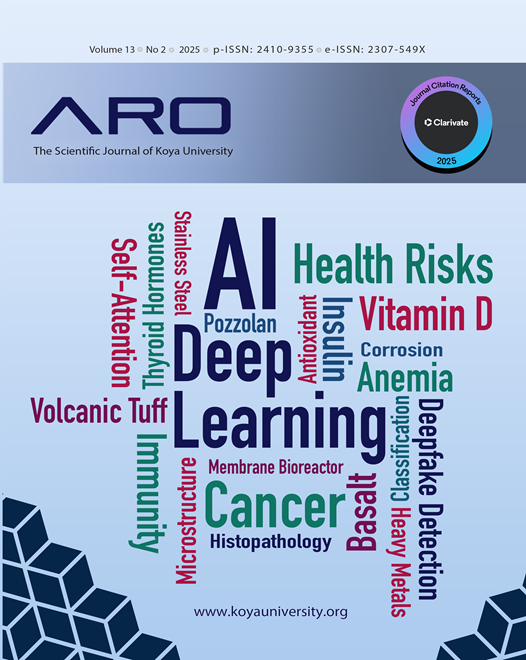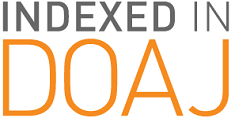Impact of Vitamin D Deficiency on Iron Deficiency Anemia
A Comparative Analysis in Iraqi Population
DOI:
https://doi.org/10.14500/aro.11980Keywords:
Anemia, Hemoglobin Ferritin, Iron deficiency, Vitamin D deficiencyAbstract
Two important health problems are iron deficiency anemia and vitamin D deficiency, as well as the ability to cope with acute and chronic diseases, because iron and vitamin D are the main elements of physiological functions in the human body. Recent studies have indicated that generalized IDA in both healthy and diseased populations may be associated with inadequate levels of VD. The research comprised 132 participants, 65 with IDA and 67 controls, the study was conducted in a competent cross-sectional design, between the two groups matched by age and gender. The laboratory findings included the study of blood indices. Ferritin, iron, hemoglobin, mean corpuscular volume, red cell distribution width, and VD levels were measured for each participant. Iron metabolism markers showed highly significant variations between the groups. Patients with IDA exhibited considerably lower levels of iron indicators than the healthy control group, except for total iron binding capacity (TIBC), which was increased among the patients. The normal control group showed substantially higher serum VD levels than patients with iron deficient anemia (p < 0.035). This distinction suggests a high positive link between VD levels and iron metabolism markers, except for TIBC, which exhibited a negative correlation. The results showed a significant correlation between VD levels and several iron metabolism markers in the research participants. This suggests that VD may affect how iron is metabolized and help treat IDA. To fully understand the underlying mechanisms and any therapeutic benefit, further research is needed.
Downloads
References
Abdellateif, M.S., Shaarawy, S., Elesawy, Y.F., Mansour, M., Tharwat, E., Ibrahim, N.H., and Eissa, M.S., 2020. The role of vitamin D, platelet-derived growth factor and insulin-like growth factor 1 in the progression of thyroid diseases. Asian Pacific Journal of Cancer Prevention, 21, pp.2083-2089. DOI: https://doi.org/10.31557/APJCP.2020.21.7.2083
Akhtar, S., Ismail, T., Atukorala, S., and Arlappa, N., 2013. Micronutrient deficiencies in South Asi-current status and strategies. Trends Food Science and Technology, 31, pp.55-62. DOI: https://doi.org/10.1016/j.tifs.2013.02.005
Al-Zuhairy, S.H., Darweesh, M.A., Othman, M.A.M., and Al-Zuhairy, N.A.S., 2022. Vitamin D deficiency in young children with iron deficiency in Misan province, Iraq. Journal of Medicine and Life, 15, pp. 387-391. DOI: https://doi.org/10.25122/jml-2021-0264
Andrukhov, O., Andrukhova, O., Hulan, U., Tang, Y., Bantleon, H.P., and Rausch-Fan, X., 2014. Both 25-hydroxyvitamin-D3 and 1,25-dihydroxyvitamin-D3 reduces inflammatory response in human periodontal ligament cells. PLoS One, 9, p.e90301. DOI: https://doi.org/10.1371/journal.pone.0090301
Auerbach, M., and Adamson, J.W., 2016a. How we diagnose and treat iron deficiency anemia. American Journal of Hematology, 91, pp.31-38.
Auerbach, M., and Adamson, J.W., 2016b. How we diagnose and treat iron deficiency anemia. American Journal of Hematology, 91, pp.31-38. DOI: https://doi.org/10.1002/ajh.24201
Azizi-Soleiman, F., Vafa, M., Abiri, B., and Safavi, M., 2016. Effects of iron on vitamin D metabolism: Asystematic review. International Journal of Preventive Medicine, 7, p.126. DOI: https://doi.org/10.4103/2008-7802.195212
Bacchetta, J., Zaritsky, J.J., Sea, J.L., Chun, R.F., Lisse, T.S., Zavala, K., Nayak, A., Wesseling-Perry, K., Westerman, M., Hollis, B.W., Salusky, I.B., and Hewison, M., 2014a. Suppression of iron-regulatory hepcidin by vitamin D. Journal of the American Society of Nephrology, 25, pp.564-572.
Bacchetta, J., Zaritsky, J.J., Sea, J.L., Chun, R.F., Lisse, T.S., Zavala, K., Nayak, A., Wesseling-Perry, K., Westerman, M., Hollis, B.W., Salusky, I.B., and Hewison, M., 2014b. Suppression of iron-regulatory hepcidin by vitamin D. Journal of the American Society of Nephrology, 25, pp.564-572. DOI: https://doi.org/10.1681/ASN.2013040355
Boettger, P.C., Knupp, C.L., Liles, D.K., and Walker, K., 2017. Vitamin D deficiency in adult sickle cell patients. Journal of the National Medical Association, 109, pp.36-43. DOI: https://doi.org/10.1016/j.jnma.2016.10.003
Camaschella, C., 2019. Iron deficiency. Blood, The Journal of the American Society of Hematology, 133, pp.30-39. DOI: https://doi.org/10.1182/blood-2018-05-815944
Caprio, M., Infante, M., Calanchini, M., Mammi, C., and Fabbri, A., 2017. Vitamin D: Not just the bone. Evidence for beneficial pleiotropic extraskeletal effects. Eating and Weight Disorders, 22, pp.27-41. DOI: https://doi.org/10.1007/s40519-016-0312-6
Chouraqui, J.P., 2022. Dietary approaches to iron deficiency prevention in childhood-a critical public health issue. Nutrients, 14, p.1604. DOI: https://doi.org/10.3390/nu14081604
Crichton, R.R., Wilmet, S., Legssyer, R., and Ward, R.J., 2002. Molecular and cellular mechanisms of iron homeostasis and toxicity in mammalian cells. Journal of Inorganic Biochemistry, 91, pp.9-18. DOI: https://doi.org/10.1016/S0162-0134(02)00461-0
De Benoist, B., Cogswell, M., Egli, I., Wojdyla, D., and Mclean, E., 2008. Worldwide prevalence of anaemia, WHO vitamin and mineral nutrition information system, 1993-2005. Public Health Nutrition, 12, pp.444-454. DOI: https://doi.org/10.1017/S1368980008002401
De Martinis, M., Allegra, A., Sirufo, M.M., Tonacci, A., Pioggia, G., Raggiunti, M., Ginaldi, L., and Gangemi, S., 2021. Vitamin D deficiency, osteoporosis and effect on autoimmune diseases and hematopoiesis: A review. International Journal of Molecular Sciences, 22, p.8855. DOI: https://doi.org/10.3390/ijms22168855
El-Adawy, E.H., Zahran, F.E., Shaker, G.A., and Seleem, A., 2019. Vitamin D status in Egyptian adolescent females with iron deficiency anemia and its correlation with serum iron indices. Endocrine Metabolic and Immune Disorders Drug Targets, 19, pp.519-525. DOI: https://doi.org/10.2174/1871530318666181029160242
El-Sharkawy, A., and Malki, A., 2020. Vitamin D signaling in inflammation and cancer: Molecular mechanisms and therapeutic implications. Molecules, 25, p.3219. DOI: https://doi.org/10.3390/molecules25143219
Göring, H., 2018. Vitamin D in nature: Aproduct of synthesis and/or degradation of cell membrane components. Biochemistry (Mosc), 83, pp.1350-1357. DOI: https://doi.org/10.1134/S0006297918110056
Grygorieva, N.V., Tronko, M.D., Kovalenko, V.M., Komisarenko, S.V., Tatarchuk, T.F., Dedukh, N.V., Veliky, M.M., Strafun, S.S., Komisarenko, Y.I., Kalashnikov, A.V., Orlenko, V.L., Pankiv, V.I., Pankiv, O.V., Gogunska, I.V., and Regeda, S.I., 2023. Diagnosis, prevention and treatment of vitamin D deficiency in adults. Pain Joints Spine, 13, pp.60-76. DOI: https://doi.org/10.22141/pjs.13.2.2023.368
Hwalla, N., Al Dhaheri, A.S., Radwan, H., Alfawaz, H.A., Fouda, M.A., Al-Daghri, N.M., Zaghloul, S., and Blumberg, J.B., 2017. The prevalence of micronutrient deficiencies and inadequacies in the middle east and approaches to interventions. Nutrients, 9, p.229. DOI: https://doi.org/10.3390/nu9030229
Jáuregui-Lobera, I., 2014. Iron deficiency and cognitive functions. Neuropsychiatric Disease and Treatment, 10, pp.2087-2095. DOI: https://doi.org/10.2147/NDT.S72491
Killip, S., Bennett, J.M., and Chambers, M.D., 2007. Iron deficiency anemia. American Family Physician, 75, pp.671-678.
Kulling, P.M., Olson, K.C., Olson, T.L., Feith, D.J., and Loughran, T.P. Jr., 2017. Vitamin D in hematological disorders and malignancies. European Journal of Haematology, 98, pp.187-197. DOI: https://doi.org/10.1111/ejh.12818
Lee, J.A., Hwang, J.S., Hwang, I.T., Kim, D.H., Seo, J.H., and Lim, J.S., 2015. Low vitamin D levels are associated with both iron deficiency and anemia in children and adolescents. Pediatric Hematology and Oncology, 32, pp.99-108. DOI: https://doi.org/10.3109/08880018.2014.983623
Malczewska-Lenczowska, J., Sitkowski, D., Surała, O., Orysiak, J., Szczepańska, B., and Witek, K., 2018. The association between iron and vitamin D status in female elite athletes. Nutrients, 10, p.167. DOI: https://doi.org/10.3390/nu10020167
Misra, M., Pacaud, D., Petryk, A., Collett-Solberg, P.F., Kappy, M., and Drug and Therapeutics Committee of the Lawson Wilkins Pediatric Endocrine Society., 2008. Vitamin D deficiency in children and its management: Review of current knowledge and recommendations. Pediatrics, 122, pp.398-417. DOI: https://doi.org/10.1542/peds.2007-1894
Mohsen, A.A., and Aljoofy, I.K., 2020. Correlation between vitamin D3 level and iron deficiency anemia in Iraqi high school students in Baghdad city, Iraq. Biochemical and Cellular Archives, 20, p.6457.
Musaiger, A.O., Hassan, A.S., and Obeid, O., 2011. The paradox of nutrition-related diseases in the Arab Countries: The need for action. International Journal of Environmental Research and Public Health, 8, pp.3637-3671. DOI: https://doi.org/10.3390/ijerph8093637
Nairz, M., Schroll, A., Sonnweber, T., and Weiss, G., 2010. The struggle for iron-a metal at the host-pathogen interface. Cellular Microbiology, 12, pp.1691-1702. DOI: https://doi.org/10.1111/j.1462-5822.2010.01529.x
Rochette, L., Gudjoncik, A., Guenancia, C., Zeller, M., Cottin, Y., and Vergely, C., 2015. The iron-regulatory hormone hepcidin: A possible therapeutic target? Pharmacology and Therapeutics, 146, pp.35-52. DOI: https://doi.org/10.1016/j.pharmthera.2014.09.004
Sim, J.J., Lac, P.T., Liu, I.L.A., Meguerditchian, S.O., Kumar, V.A., Kujubu, D.A., and Rasgon, S.A., 2010. Vitamin D deficiency and anemia: A cross-sectional study. Annals of Hematology, 89, pp.447-452. DOI: https://doi.org/10.1007/s00277-009-0850-3
Smith, E.M., Alvarez, J.A., Kearns, M.D., Hao, L., Sloan, J.H., Konrad, R.J., Ziegler, T.R., Zughaier, S.M., and Tangpricha, V., 2017. High-dose vitamin D3 reduces circulating hepcidin concentrations: A pilot, randomized, double-blind, placebo-controlled trial in healthy adults. Clinical Nutrition, 36, pp.980-985. DOI: https://doi.org/10.1016/j.clnu.2016.06.015
Smith, E.M., and Tangpricha, V., 2015. Vitamin D and anemia: Insights into an emerging association. Current Opinion in Endocrinology Diabetes and Obesity, 22, pp.432-438. DOI: https://doi.org/10.1097/MED.0000000000000199
Sun, C.C., Vaja, V., Babitt, J.L., and Lin, H.Y., 2012. Targeting the hepcidin-ferroportin axis to develop new treatment strategies for anemia of chronic disease and anemia of inflammation. American Journal of Hematology, 87, pp.392-400. DOI: https://doi.org/10.1002/ajh.23110
Vaquero, M.P., García-maldonado, E., Gallego-narbón, A., Zapatera, B., Alcorta, A., and Martínez-Suárez, M., 2024. Iron deficiency is associated with elevated parathormone levels, low vitamin D status, and risk of bone loss in omnivores and plant-based diet consumers. International Journal of Molecular Sciences, 25, p.10290. DOI: https://doi.org/10.3390/ijms251910290
Wintrobe, M.M., 2009. Wintrobe’s Clinical Hematology. Lippincott Williams and Wilkins, United States.
Zouine, N., Lhilali, I., Godderis, L., El Midaoui, A., El Jaafari, S., and Filali-Zegzouti, Y., 2024. The interplay between vitamin D deficiency, iron status, and anemia risk in moroccan women of reproductive age: A cross-sectional analysis. Epidemiologia (Basel), 5, pp.805-827. DOI: https://doi.org/10.3390/epidemiologia5040055
Downloads
Published
How to Cite
Issue
Section
License
Copyright (c) 2025 Sleman Y. Omar, Awat H. Awla, Musher I. Salih, Badinan J. Hamadamin

This work is licensed under a Creative Commons Attribution-NonCommercial-ShareAlike 4.0 International License.
Authors who choose to publish their work with Aro agree to the following terms:
-
Authors retain the copyright to their work and grant the journal the right of first publication. The work is simultaneously licensed under a Creative Commons Attribution License [CC BY-NC-SA 4.0]. This license allows others to share the work with an acknowledgement of the work's authorship and initial publication in this journal.
-
Authors have the freedom to enter into separate agreements for the non-exclusive distribution of the journal's published version of the work. This includes options such as posting it to an institutional repository or publishing it in a book, as long as proper acknowledgement is given to its initial publication in this journal.
-
Authors are encouraged to share and post their work online, including in institutional repositories or on their personal websites, both prior to and during the submission process. This practice can lead to productive exchanges and increase the visibility and citation of the published work.
By agreeing to these terms, authors acknowledge the importance of open access and the benefits it brings to the scholarly community.
Accepted 2025-07-14
Published 2025-08-09
















 ARO Journal is a scientific, peer-reviewed, periodical, and diamond OAJ that has no APC or ASC.
ARO Journal is a scientific, peer-reviewed, periodical, and diamond OAJ that has no APC or ASC.